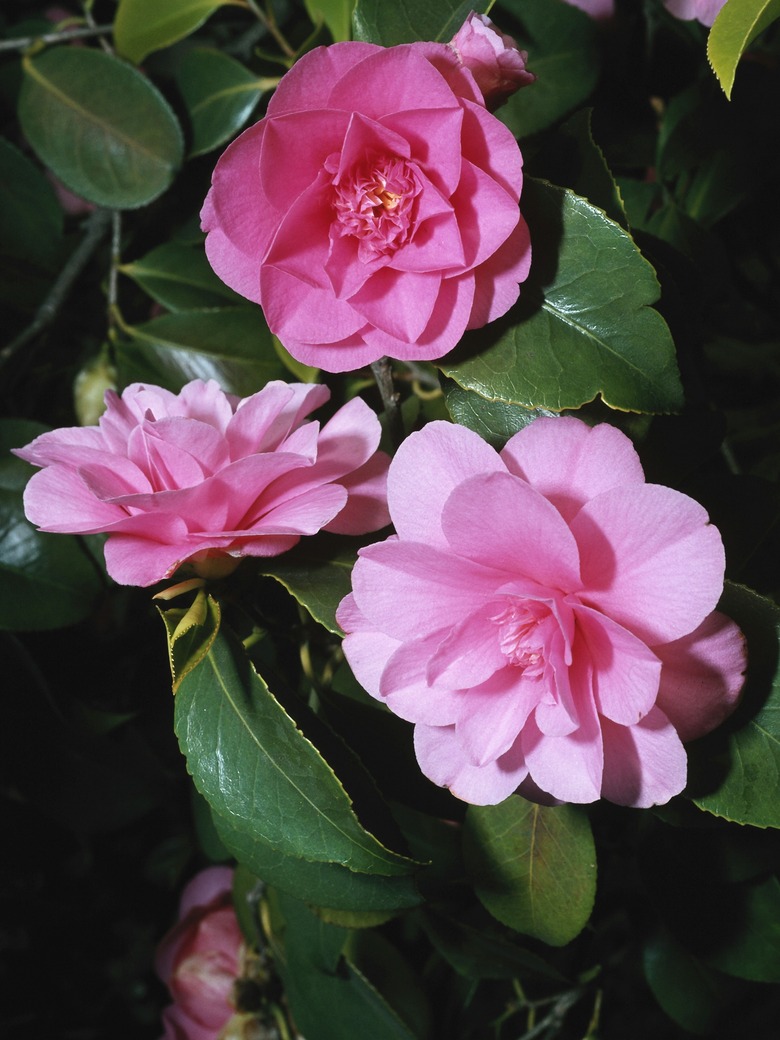How To Grow Camellias In Texas
You can find flowering, evergreen camellia shrubs (Camellia spp.) in varieties that will grow in all parts of Texas. The big state's U.S. Department of Agriculture plant hardiness zones range from 6a to 9b. Camellias have dark, glossy leaves and flower between fall and spring. They can grow between 10 and 25 feet tall and 6 and 10 feet wide, depending on the variety. The shrubs need moist, well-draining soil, partial shade and protection from wind. Most parts of Texas have alkaline soil, which means the soil must be amended if you want to successfully grow the shrubs in your garden. You can plant camellias in fall or spring.
- You can find flowering, evergreen camellia shrubs (Camellia spp.)
- Most parts of Texas have alkaline soil, which means the soil must be amended if you want to successfully grow the shrubs in your garden.
Step 1
Step 1
Choose a location where the camellia will get partial shade and wind protection, and won't have to compete with other trees and plants for nutrients.
Step 2
Step 2
Excavate an area 18 to 24 inches deep, three times the width of the root ball and long enough to accommodate the number of shrubs you're planting. Camellias need to be spaced at least 5 feet apart.
Step 3
Step 3
Thoroughly mix 2 parts pine bark mulch, 1 part clean sand and 1 part aged cow manure or compost to fill the hole. How much of each you need will depend on how much soil you excavated. You need enough to fill the hole to at least 3 inches above the soil surface.
Step 4
Step 4
Fill the hole with the planting mixture until the hole is 1 to 2 inches less deep than the height of the shrub's root ball. Form a mound of planting mixture where you will set the root ball.
- Choose a location where the camellia will get partial shade and wind protection, and won't have to compete with other trees and plants for nutrients.
- Fill the hole with the planting mixture until the hole is 1 to 2 inches less deep than the height of the shrub's root ball.
Step 5
Step 5
Rinse the shrub roots with water and set the root ball in the planting hole over the planting mound so the tops of the roots are about 1 to 2 inches above soil level. Fill in the hole with the planting mixture to the same depth the plant was at in the container. As the soil settles over the next few days, you may need to add more of the planting mixture.
Step 6
Step 6
Spread a 3-inch layer of organic mulch around the base of the shrub. Keep the mulch about 6 inches from the plant base. The mulch will help prevent weeds from growing and keep the soil moist.
Step 7
Step 7
Water the camellias deeply, to a depth of about 15 inches, every seven to 14 days. Allow the top of the soil to dry between waterings.
- Rinse the shrub roots with water and set the root ball in the planting hole over the planting mound so the tops of the roots are about 1 to 2 inches above soil level.
- Keep the mulch about 6 inches from the plant base.
Step 8
Step 8
Use an acid-loving-plant fertilizer in after the blooms fade. Mix 1 tablespoon of fertilizer in 1 gallon of water, and water over the root zone. One gallon covers 10 square feet.
Step 9
Step 9
Prune as needed after the shrub has finished blooming. Remove dead or damaged branches back to the base using pruning shears. Prune back individual branches that stick out or don't follow the natural shape of the shrub to the desired length at a point just outside a leaf set or growth scar. Thin out a few center branches if the shrub is crowded and light is not getting through, or flowers don't have room to bloom.
- Use an acid-loving-plant fertilizer in after the blooms fade.
- Prune back individual branches that stick out or don't follow the natural shape of the shrub to the desired length at a point just outside a leaf set or growth scar.
Tip
Watch for petal blight. If flowers turn brown before they should, remove the affected flowers and replace the mulch.
Tip
Check the undersides of leaves regularly for scale or other insect pests. If the leaves begin to turn yellow or get brown spots, this can indicate insect infestation. For moving insects such as aphids, washing the leaves with pressurized water can remedy the problem. For scale that appears as hard bumps under the leaves, treat with horticultural oil spray before or after bloom. Coat the tops and bottoms of the leaves with the premixed spray.
Warning
Always read the manufacturer's instructions before using fertilizer or pesticides.
Things Needed
- Shovel
- Pine bark mulch
- Builder's sand
- Aged manure
- Organic mulch
- Acid-loving-plant fertilizer
- Pruning shears
References
- Texas A&M AgriLife Extension Service: Camellias — Southern Charm With a History
- Texas A&M AgriLife Extension Service: Camellias
- Texas A&M AgriLife Extension Service: Camellias for Texas Gardens
- Southern Living: Camellia Planting Guide
- PLANTanswers: Growing Camellias in South Central Texas
- American Camellia Society: Growing Camellias in Austin
- Bartlett Tree Experts: Plant Health Care Recommendations for Camellia
- American Camellia Society: Planting Camellias
- Texas A&M AgriLife Extension Service: Texas Hardiness Zones
- Clemson University Cooperative Extension Service: Camellia
